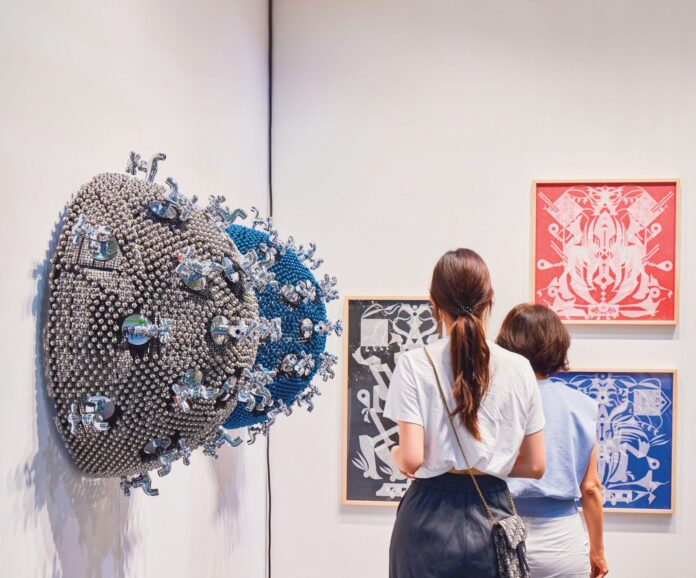South Korea’s art market in 2022 shattered records, bolstered by the launch of Frieze Seoul and the country’s early lifting of Covid travel restrictions compared to the rest of East Asia. This year has seen a readjustment, dropping to 2019 levels with global economic woes echoing in Korea. Meanwhile other Asian art centres, particularly Hong Kong, seek to reclaim their former market positions. Dealers hope that the September art week surrounding Frieze Seoul and Korea International Art Fair Seoul (Kiaf) will provide a much-needed boost.
“During the Covid era, the market was so overheated, and now that it is back down I feel it is more stable,” says Jane Yoon, managing director, South Korea at Sotheby’s. “Customers are more cautious than they have been in the past two years, but it is clear that the number of buyers in the Korean market is larger than before. Pre-pandemic, only a rarified few people collected art, but now a significant number of people are interested in buying art. The art market is popularising.”
A trillion-won market
The Korea Arts Management Service (Kams) tallied the total art market volume as worth 1 trillion won ($782m) in 2022, up 32.2% from 756.3bn won in 2021. The auction market in the first half of this year was 80bn won—down by 9.9% from 88.8bn won in the second half of 2022, and by 44.8% from 145bn won in the first half of 2022. Kams found that sales of high-end works are particularly affected, probably due to increased interest rates.
“The market size has returned to pre-Covid times,” says Hyunsoon Do, the chief executive of K Auction, adding that “the Korean art market is particularly volatile because [it] is thin”, rising and falling sharply. “However, you can also find the floor quickly. While the global art market continues to decline, Korea is believed to have stopped declining and reached its bottom.”
Do says South Korea has managed inflation comparatively well, with its central bank benchmark interest rate currently lower than that of the US. “Since there are no plans to increase it further, and we expect it to go lower, asset prices will go up from the second half of the year, which will naturally be a positive for the art market again. I think that from next year, if not from the second half of the year, the Korean art market will be in an upward mode again.”
The use of art as an investment vehicle has seen continued enthusiasm in Korea amid the economic doldrums, with fractional art investment expanding its appeal. One fractionals firm, Yeolmae, between 2020 and 2022 purchased 400bn in works and resold 200bn won of shares. Yoon posits that purely speculative buyers have exited with the market’s decline, though young collectors remain as cognisant of investment as aesthetics. According to Taehee Joung, a fine art specialist at Seoul Auction: “The market for young artists, whose prices have risen sharply, has been hit the hardest. The blue-chip market is becoming the baseline for maintaining the current market, and the market for antique art and Korean painting is growing gradually.”
Despite this year’s slowed market, Frieze Seoul is unlikely to see a sophomore slump, with Korea’s recently reopened neighbours providing new exhibitors and collectors as well as resumed competition. Around 40% of Frieze Seoul’s more than 120 participating galleries are from Asia, including newcomers like Shanghai’s Antenna Space and Ho Chi Minh City’s Galerie Quynh.
Energetic atmosphere
Emma Son, the senior director of Lehmann Maupin Seoul, predicts an energetic fair atmosphere: “Last year, pandemic shutdowns affected collectors’ ability to travel internationally, especially for those in China, but this year, the restrictions have been lifted, so I think many major collectors from Asia will probably visit Korea. But I think we’ll just have to see whether that produces sales.”
Korea’s collector base and comparative ease of operations have prompted many international blue-chip galleries to establish permanent venues in Seoul, with White Cube the latest to launch in the city this September. Although the pace of expansions into Seoul has slowed compared with last year, Son says, “Interest is still high”. Beyond opening full facilities, “overseas galleries will continue to seek representation in Korea”.
Sotheby’s Yoon says: “One can’t ignore Art Basel Hong Kong, but Frieze operates at the same level and is building Korea into another international art platform.” Even if some sales siphon back to Hong Kong and other centres, Yoon says, Korean collectors are Asia’s biggest consumers of contemporary art and “are considered to be the most sophisticated in the contemporary art market among Asian collectors, even in auctions”.
Collectors under the age of 50 account for about 80% of sales, Yoon says. “Increasing accessibility to the Korean art market through Frieze Seoul will see things improve in the coming year and in the years to come.”
• Frieze Seoul, Coex, 6-9 September; Kiaf, Coex, 7-10 September

























